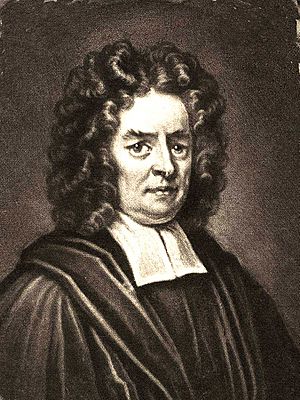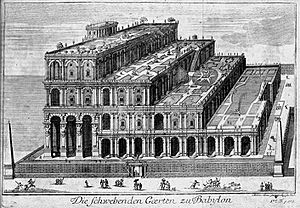Humphrey Prideaux facts for kids
Quick facts for kids Humphrey Prideaux |
|
|---|---|
| Dean of Norwich | |
 |
|
| Church | Church of England |
| Diocese | Diocese of Norwich |
| In Office | 1702-1714 |
| Personal details | |
| Born | 3 May 1648 |
| Died | 1 November 1724 (aged 76) |
| Nationality | British |
| Education | Westminster School London Liskeard Grammar School |
Humphrey Prideaux (born May 3, 1648 – died November 1, 1724) was an important church leader from Cornwall, England. He was also an expert in Eastern cultures. From 1702, he served as the Dean of Norwich, a high position in the Church of England. He believed in a simpler style of church worship, known as Low Churchism. In politics, he supported the Whig party.
Contents
Early Life and Education
Humphrey Prideaux was born in Padstow, Cornwall, on May 3, 1648. He was the third son of Edmond Prideaux. His mother was the daughter of John Moyle.
He attended Liskeard grammar school and Bodmin grammar school. Later, he went to Westminster School in London. His uncle, William Morice, helped him get into Westminster.
On December 11, 1668, he started studying at Christ Church, Oxford University. He earned several degrees there, including a Bachelor of Arts (B.A.) in 1672 and a Doctor of Divinity (D.D.) in 1686. At the university, he was known for being a very good scholar. He helped edit important books, including one about the Roman historian Florus.
Church Career and Public Service
Humphrey Prideaux gained support from important people like Heneage Finch, who was the first Earl of Nottingham. Prideaux tutored Finch's son. In 1677, he became the rector (a type of priest) of Llandewy-Velfrey in Wales. This was a "sinecure" job, meaning it paid him without requiring much work.
In 1679, he became the rector of St Clement's, Oxford. He also taught Hebrew at Christ Church College. In 1681, he was given a special position called a canonry at Norwich Cathedral. He also became the rector of Bladon, Oxfordshire, in 1683. This included the church in Woodstock.
Prideaux later moved from Oxford to Norwich. He exchanged his rectory in Bladon for one in Saham-Toney, Norfolk, in 1686. He stayed there until 1694. He often debated with Roman Catholics, especially about the rules of the Anglican Church.
As a canon at Norwich, he worked to improve the church's finances. He also organized their historical records. In December 1688, he became the archdeacon of Suffolk. He held this job until 1694.
During this time, many church leaders had to swear loyalty to the new King William III. Prideaux made sure that most clergymen in his area took these oaths. Only a few refused, becoming "nonjurors."
In 1689, Prideaux supported changes to the Book of Common Prayer. He hoped these changes would help different Christian groups, called Dissenters, join the Church of England. He also worked on laws to prevent priests from holding too many jobs at once. He also helped create a bill to stop "clandestine marriages," which were secret or illegal weddings.
From 1689 to 1694, Prideaux lived in Saham. He turned down a teaching job at Oxford in 1691, which he later regretted. He moved back to Norwich because Saham did not suit his health. In 1697, he became the vicar of Trowse, near Norwich.
He became the Dean of Norwich on June 8, 1702. This was a very important leadership role.
Around 1709, Prideaux became very ill with kidney stones. This made it hard for him to preach. He had an operation, but it did not go well. He also suffered from other health problems. He passed away on November 1, 1724, at the deanery in Norwich. He was buried in Norwich Cathedral.
His Writings and Books
Humphrey Prideaux wrote several important books. One of his famous works was A Life of Mahomet (1697). This book also included an argument against people called deists, who believed God created the world but didn't interfere with it.
His most well-known work was The Old and New Testament connected in the History of the Jews and Neighbouring Nations (1715–1717). This book explained the history of the Jewish people and their neighbors. It covered the time between the Old and New Testaments in the Bible. Many copies of this book were printed. It was one of the first English books to use the term "Vulgar Era" for the common calendar system.

Other works by Prideaux include:
- Marmora Oxoniensia (1676): This was a catalog and timeline of ancient Greek and Roman sculptures.
- De Jure Pauperis et Peregrini (1679): This was an edition of a Hebrew text by Maimonides, with a Latin translation.
- A Compendious Introduction for Reading ... Histories (1682): A guide to reading history.
- Directions to Churchwardens (1701): A guide for church officials.
- The Original and Right of Tithes (1710): A book about church taxes.
- Ecclesiastical Tracts (1716): A collection of his writings on church matters.
His letters, written between 1674 and 1722, were also published.
Family Life
On February 16, 1686, Humphrey Prideaux married Bridget Bokenham. She was the only child of Anthony Bokenham from Suffolk. They had one son:
- Edmund Prideaux (1693–1745): He became a lawyer and was also a talented artist.
Images for kids
-
The Hanging Gardens of Babylon, an engraving from the German edition of 1726 of The Old and New Testament connected.





